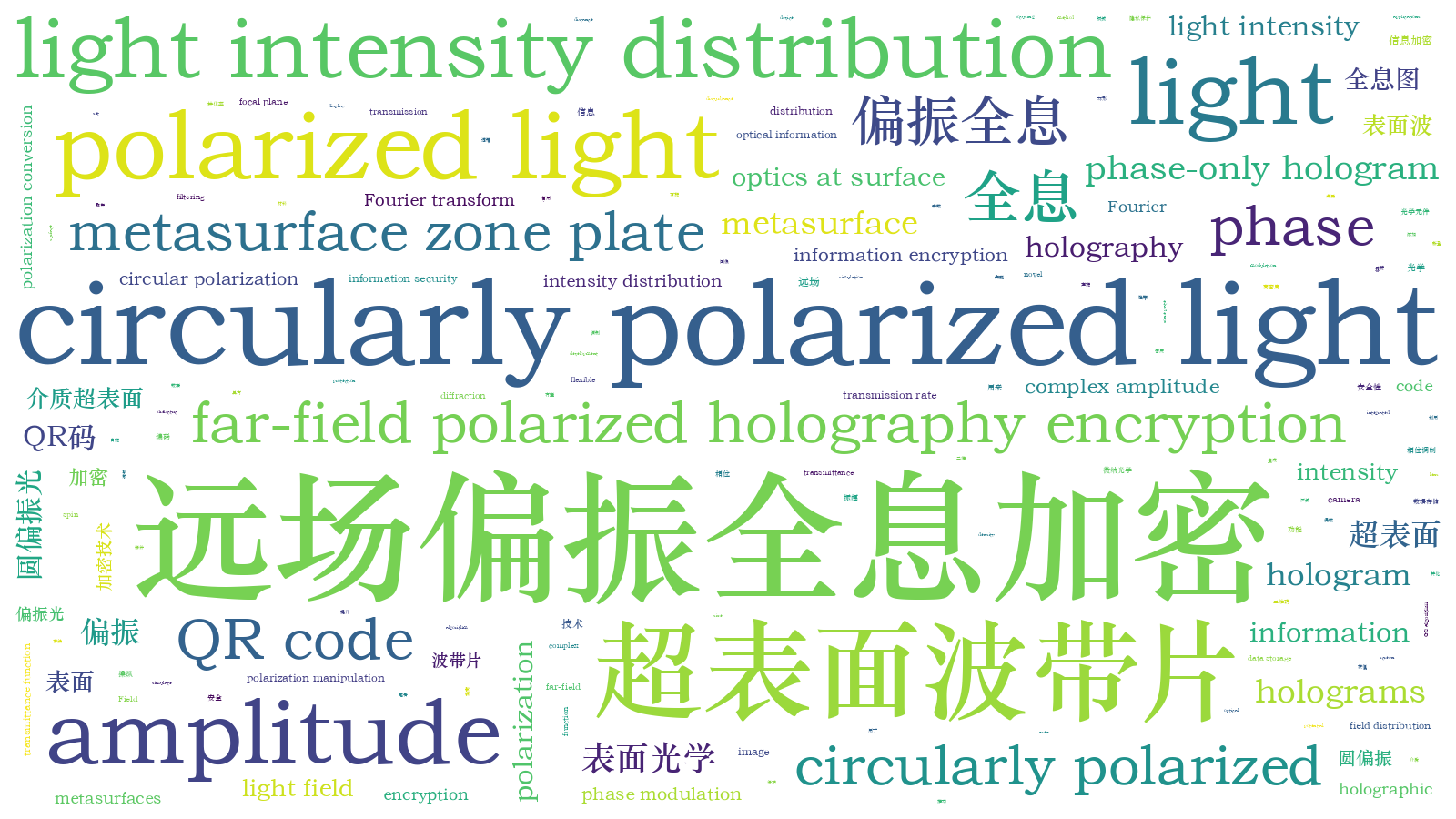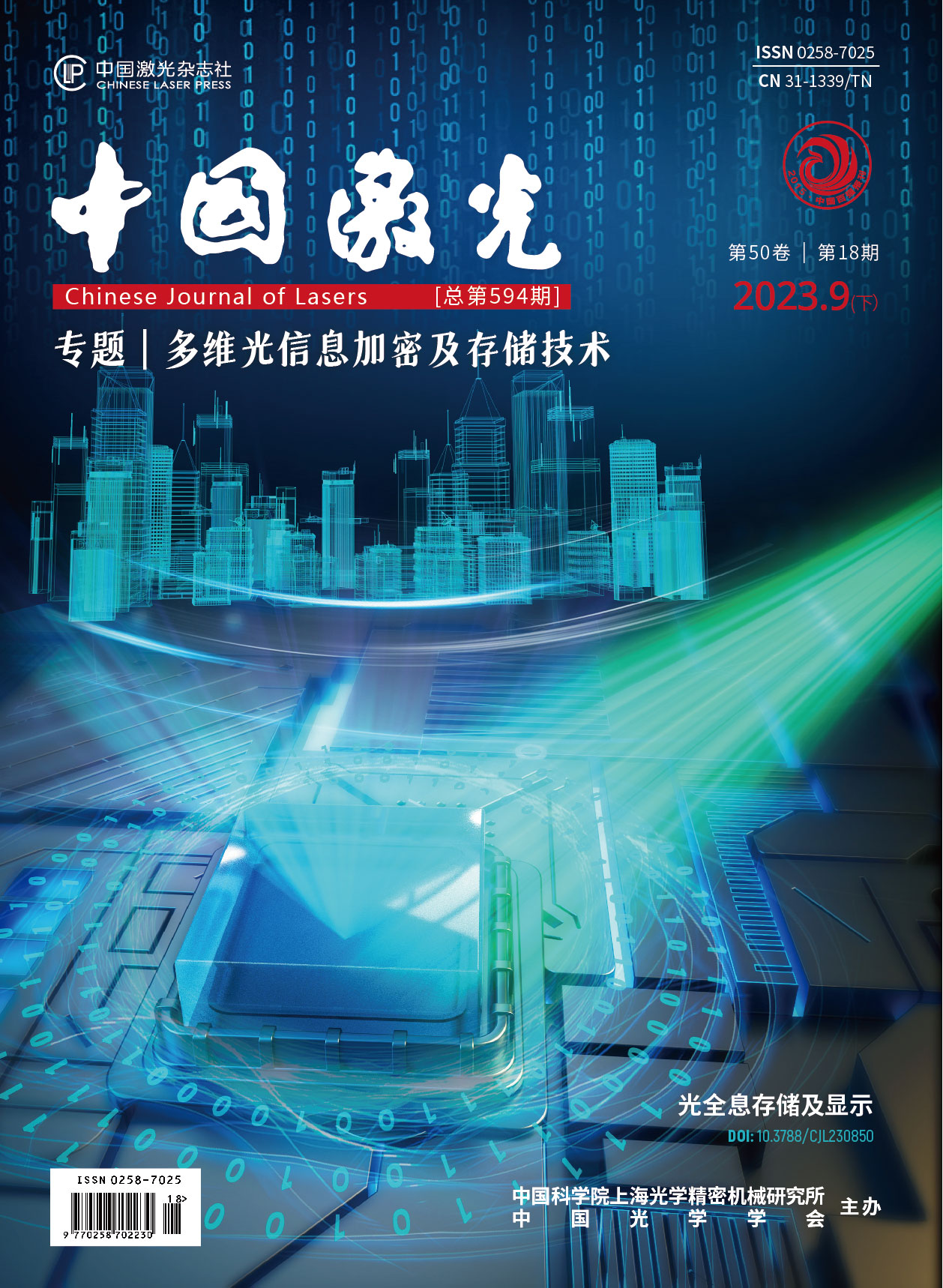基于超表面波带片的远场偏振全息加密  下载: 619次特邀研究论文【增强内容出版】
下载: 619次特邀研究论文【增强内容出版】
Metasurfaces have flexible polarization manipulation functions; however, a lens must be added to obtain the desired far-field-polarized holographic images. This study demonstrates a novel far-field polarization holographic encryption method using flexible polarization manipulation and the focusing capabilities of metasurface zone plates. Two spin-multiplexed metasurface zone plates are integrated into a single metasurface device, where the amplitude (right-handed circular polarization conversion rate) of the metasurface is used to encode the odd and even annular regions of the zone plates, and its phase modulation is utilized to encode two holograms of the transmitted right and left circularly polarized light. Additionally, QR codes and amplitude-only/phase-only holograms are used to hide encrypted information and improve data security. The proposed encryption technology is expected to enhance data security and privacy protection and promote the development of optical information encryption and high-density data storage.
The metasurface consisted of odd and even zones of a metasurface zone plate. When left-handed circularly polarized light is incident on the surface, the odd and even zones transform the light into right- and left-handed circularly polarized light, respectively. The polarization conversion efficiencies are 100% and 0% for the odd and even zones, respectively. For the odd zones, the amplitude of the transformed right-handed circularly polarized light is equal to one. For the even zones, the amplitude of the transformed left-handed circularly polarized light is also one. Therefore, the amplitudes of the odd and even zones can be considered amplitude-only odd and even Fresnel zone plates, respectively. In addition, the phases of the odd and even zones were designed as holograms corresponding to right- and left-handed circularly polarized light, respectively (Fig. 2). Thus, the two types of holograms have their respective holographic images in the same focal plane of the amplitude-only odd and even Fresnel zone plates. However, because the images overlapped, the desired encrypted holographic images could not be identified. Therefore, filtering out the right- or left-handed circular polarization can decrypt the corresponding encrypted holographic images.
We use a QR code-generating website to create QR codes that correspond to amplitude-only and phase-only holograms. We then apply the GS algorithm, based on the Fourier transform relationship, to generate either an amplitude-only or a phase-only hologram. Subsequently, the amplitude-only hologram and phase-only hologram undergo Fourier transform to produce an encrypted intensity profile and an encrypted intensity distribution, respectively (Fig. 3). The odd and even zones refer to the designed holograms corresponding to the output right- and left-handed circular polarization components, respectively. Although transmitted phases exist for the left and right circular-polarization components in the odd and even zones, respectively, the amplitudes of these phases are essentially zero and can be disregarded (Fig. 4). To simulate the diffraction light field distribution of actual metasurfaces, we match the phase and amplitude of a single pixel in the annular region in Figs. 4(c1) and (d1) and Figs. 4(c2) and (d2) to the transmitted phase and transmission rate of all corresponding positions of the metasurface using the phase and transmission rate databases of differently sized meta-atoms in Figs. 2(b)-(e). The complex amplitudes of the left- and right-circularly polarized light transformed by the metasurface are calculated using the transmitted phases and geometric phases in Figs. 4(e1) and (e2). Finally, the diffraction light field distribution at the focal plane is calculated using the x- and y-polarization components of the actual complex amplitude of the circularly polarized light and diffraction formula (3) and (4). Because the transmission rate and phase of the meta-atoms differ from the expected amplitude and phase, the center of the Fourier hologram focal plane may have a high-intensity bright spot, making it impossible to display the hologram image. To eliminate the disturbance of the bright spot in the hologram image of the transmitted left-circularly polarized light, we set all values in the central area of the actual light intensity distribution with a size of 16.5 μm×16.5 μm to 0, which is equivalent to physically blocking the central zero-order with an opaque square screen, thus obtaining the QR code image represented in Fig. 5. Figure 5 shows the simulation results representing the hologram image at a simulated distance of z=14.1 mm. The transmitted QR code intensity profile could not be recognized by the phone camera when the left-handed circularly polarized incident light is used. However, when the transmitted right-handed circularly polarized light is filtered out, the calculated QR code intensity profile can be identified using a phone camera. The decrypted information corresponds to the amplitude-only hologram, and we obtain the final decryption information by performing a Fourier transform on the amplitude-only hologram transmittance function. Moreover, by filtering out the transmitted left-circularly polarized light, the calculated QR code intensity profile can be identified using a phone camera. In this case, the decrypted information corresponds to a phase-only hologram, and we obtain the final decryption information using the Fourier transform of the phase-only hologram transmittance function (Fig. 5).
We introduce a novel approach for achieving far-field polarized holography encryption by integrating two types of metasurface zone plates into a single dielectric spin-multiplexed metasurface. Specifically, we utilized amplitude-only odd- and even-zone plates for their amplitudes and phase holograms of the transmitted right- and left-circularly polarized light for their phases. Our results demonstrate that encrypted information can only be decrypted when a single circularly polarized state is filtered. The use of QR codes and amplitude-only/phase-only holograms further improves information security. The proposed metasurface technology has potential applications in the fields of data storage and information encryption.
夏天, 谢振威, 袁小聪. 基于超表面波带片的远场偏振全息加密[J]. 中国激光, 2023, 50(18): 1813015. Tian Xia, Zhenwei Xie, Xiaocong Yuan. Far-Field Polarized Holographic Encryption by Metasurface Zone Plates[J]. Chinese Journal of Lasers, 2023, 50(18): 1813015.







